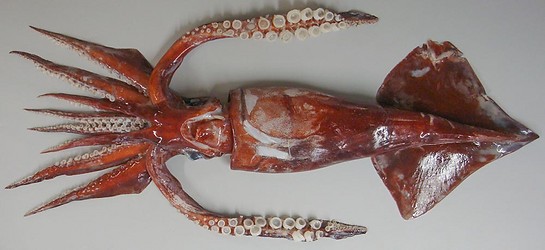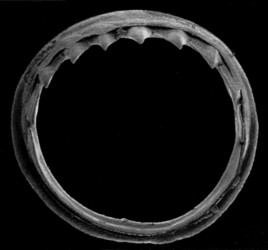Todarodes filippovae
Michael Vecchione and Richard E. YoungIntroduction
T. filippovae is a large, oceanic pelagic squid that reaches a size of at least 520 mm ML in females and 400 mm ML in males (Rodhouse, 1998). Its size and abundance in the southwest Pacific suggests potential for commercial exploitation (Rodhouse, 1998).
Brief diagnosis:
A Todarodes with ...
- 7-13 teeth on largest club sucker.
- 12-14 sucker rown on club manus.
Characteristics
- Arms
- Basal arm suckers with about 10 teeth but without alternating small teeth.
- Right arm IV hectocotylized on the distal 21-36% of the arm length.
- Hectocotylized region with ventral protective membrane and trabeculae expansively developed.
- Basal arm suckers with about 10 teeth but without alternating small teeth.
- Tentacles
- Club manus with 12-14 transverse sucker rows.
- Largest median manus sucker ring with 7-13 teeth.
- Diameter of largest median manus sucker 2.7-4.5% of ML.
- Two pairs of carpal suckers.
- Head
- Beaks: Descriptions can be found here: Lower beak; upper beak.
- Beaks: Descriptions can be found here: Lower beak; upper beak.
Comments
T. filippovae is very similar to T. sagittatus and T. angolensis. While the distribution of T. sagittatus is in the North Atlantic, those of T. filippovae and T. angolensis, are found in the southern hemisphere and overlap in the Benguela Current system, indian Ocean and off Australia. Much of the distribution data on T. angolensis is uncertain due to some initial confusion on the validity of the two species. (Dunning and Wormuth, 1998). In addition, Rodhouse (1998) concluded that "... the possibility should not be discounted that, across its geographical range, T. filippovae may represent more than one species."
Distribution
Type locality: Southern Indian Ocean at 35°S-38°S, 66°E-77°E.
T. filippovae is considered to be an oceanic species whose populations encroach onto the shelf edge (Rodhouse, 1998). It has a circumpolar distribution from about 30°-50°S, and is found northward in the Benguela Current System off west Africa. A distribution map can be found here.
References
Dunning, M. C. and J. H. Wormuth. 1998. The ommastrephid squid genus Todarodes: A review of systematics, distribution, and biology (Cephalopoda: Teuthoidea). . Smithsonian Contributions to Zoology, No. 586: 385-391.
Rodhouse, P. D. 1998. Todarodes filippovae in the Southern Ocean: an appraisal for exploitation and management. p. 207-215, In: Large Pelagic Squids, T. Okutani (Ed.) Japan Marine Fishery Resources Research Center, Tokyo, 269 pp.
Roper, C. F. E., M. J. Sweeney, And C. E. Nauen. 1985. FAO species catalogue. Vol. 3. Cephalopods of the World. An annotated and illustrated catalogue of species of interest to fisheries. FAO Fish. Synop., (125)3:277 pp.
Title Illustrations

| Scientific Name | Todarodes filippovae |
|---|---|
| Location | NW Chatham Rise (near New Zealand) at 43°11'S, 174°21'E |
| Comments | Bottom trawl at at 590 m depth |
| Acknowledgements | National Institute of Water & Atmospheric Research (NIWA) |
| Identified By | Darren Stevens |
| Sex | Female |
| Life Cycle Stage | Mature |
| View | Ventral |
| Size | 491 mm ML |
| Collection | NIWA |
| Image Use |
 This media file is licensed under the Creative Commons Attribution License - Version 3.0. This media file is licensed under the Creative Commons Attribution License - Version 3.0.
|
| Copyright | © |
About This Page

National Museum of Natural History, Washington, D. C. , USA

University of Hawaii, Honolulu, HI, USA
Correspondence regarding this page should be directed to Michael Vecchione at and Richard E. Young at
Page copyright © 2011 and
 Page: Tree of Life
Todarodes filippovae .
Authored by
Michael Vecchione and Richard E. Young.
The TEXT of this page is licensed under the
Creative Commons Attribution-NonCommercial License - Version 3.0. Note that images and other media
featured on this page are each governed by their own license, and they may or may not be available
for reuse. Click on an image or a media link to access the media data window, which provides the
relevant licensing information. For the general terms and conditions of ToL material reuse and
redistribution, please see the Tree of Life Copyright
Policies.
Page: Tree of Life
Todarodes filippovae .
Authored by
Michael Vecchione and Richard E. Young.
The TEXT of this page is licensed under the
Creative Commons Attribution-NonCommercial License - Version 3.0. Note that images and other media
featured on this page are each governed by their own license, and they may or may not be available
for reuse. Click on an image or a media link to access the media data window, which provides the
relevant licensing information. For the general terms and conditions of ToL material reuse and
redistribution, please see the Tree of Life Copyright
Policies.
- First online 08 March 2011
- Content changed 08 March 2011
Citing this page:
Vecchione, Michael and Richard E. Young. 2011. Todarodes filippovae . Version 08 March 2011 (under construction). http://tolweb.org/Todarodes_filippovae/77453/2011.03.08 in The Tree of Life Web Project, http://tolweb.org/












 Go to quick links
Go to quick search
Go to navigation for this section of the ToL site
Go to detailed links for the ToL site
Go to quick links
Go to quick search
Go to navigation for this section of the ToL site
Go to detailed links for the ToL site